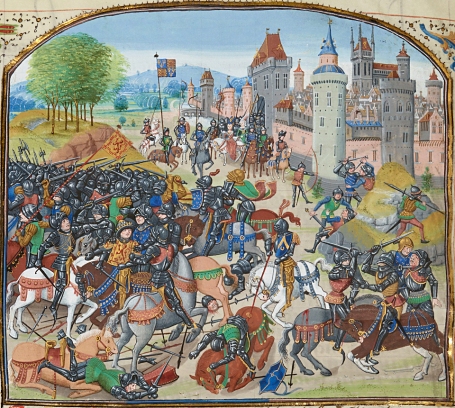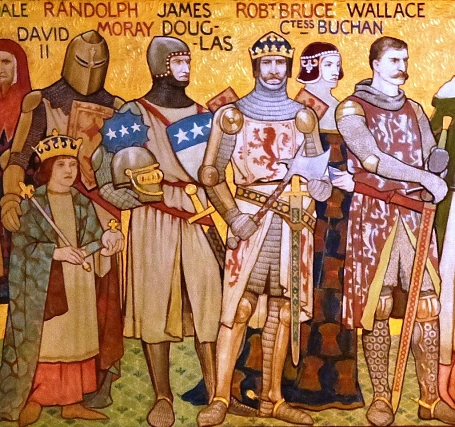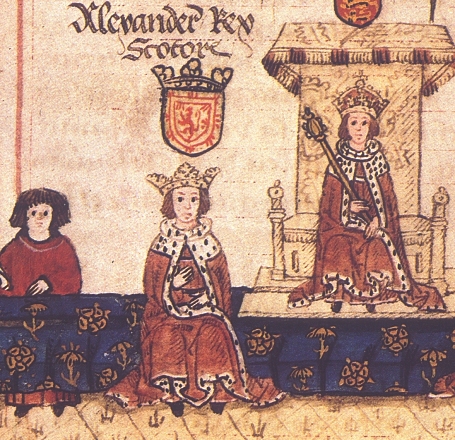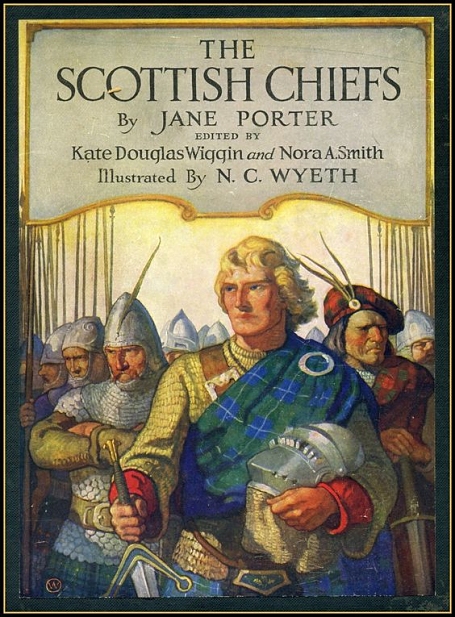The Life and Heroick Actions of the Renoun'd Sir William Wallace,
General and Governour of Scotland
by William Hamilton of Gilbertfield
Synopsis (Continued)
The truce was agreed to in February; by March the English are harrassing and killing Scots. In April, King Edward goes to Carlisle, where he calls a council to discuss methods of ridding Scotland of its nobles. Aymer Vallance hatches a plot to call all the Scots nobles of Ayrshire to the barns (barracks) at Ayr, where the entrance to the building is such that men can only enter one at a time. Upon entering, they will be killed. A vote is taken and the Englishmen agree on the plan, except for Percy who remarks that the Scots have held true to the truce, so he will remove himself to Glasgow. They also agree to call a meeting in Glasgow that day for the nobles of Clydesdale, sure that Wallace will attend at either Ayr or Glasgow with his relatives and will have no means of escape.
The meeting in Ayr was set for 18 June, and though the Scots wonder at the audacity of the English to summon them during a time of truce, they prepare to attend. Ranald Crawford calls on his friends to meet at Monkton Kirk to discuss the council. Wallace, who'd been named Warden of Scotland by this time, meets with his uncle, along with John Blair who advises them not to attend. Wallace goes into the church where he prays, then falls asleep and dreams.
In his dream, a man approaches Wallace and gives him a sword that glitters with gems. He tells Wallace that the time approaches for him to avenge all of Scotland's wrongs then leads him up a mountain and leaves. Wallace looks down from the mountaintop out over all of Scotland, which is burning and wasted.
A woman then descends into his sight, so bright and dazzling that the firelight pales. She gives him a red and green wand, then with a sapphire crosses his face. She tells him that he's been chosen by God to help people who have been wronged. She says she can't stay long – that his kin are in torment and pain. He's told that his reward on Earth for helping them will be small, but that his reward in Heaven will be eternal bliss. She gives him a book and ascends into the clouds. Wallace clutches the book to him, noting that it's in three parts; the first part written in brass, the second in gold, the third in silver. As he hastens to read the book, he wakes up.
He wakes to find a man in the church who explains the dream to him. The man tells Wallace that the man in his dream who gave him the sword was King Fergus, the fire means he must act fast, the woman was Fortune, the wand represented power, command, and chastisement. The color red means bloody battles, green stands for courage, and the sapphire is "happy chance," with which she blessed him by crossing his face. The book represents Scotland; the brass letters predict oppressive wars, gold represents honor, nobleness and victory, and silver symbolizes heavenly bliss.
Wallace thanks the man and returns to his uncle who is waiting outside. They ride home to Crosby where they spend the night and prepare to attend the council at Ayr. The next day, as they travel to Ayr, Wallace asks his uncle the location of the charter for peace that they'd signed. Crawford replies that it's in a chest back in Crosby. Wallace returns to fetch it as his uncle travels on to Ayr.
Crawford rides directly to the barns – he's the first to arrive. There are strong men on either side of the door and as Crawford enters the barn, a noose is thrown over his neck, he's drawn up and hung. Other Scots soon follow: Bryce Blair, Neil Montgomery, Wallaces, Kennedys, Campbells, Barclays, Boyds, Stuarts, "great numbers" of men are all hung one-by-one as they enter the building. When it's over, 360 Scots nobles have been put to death. The Englishmen strip them naked and throw their bodies out into the yard.
Wallace's men, who had been lead by Robert Boyd since the battle at Biggar, go to an inn near Ayr and ask the barmaid for news. She asks where Wallace is. Boyd tells her he's returned to Crosby at his uncle's request, but will be returning soon. She tells Boyd that Wallace's men should leave immediately, and when Wallace shows up she'll tell him what's happened in Ayr. Boyd leads Wallace's men to Laglane Woods. Wallace in the meantime meets up with the woman, hears about the slaughter of Scots in Ayr. He asks her to send Robert Boyd, Adam Wallace and William Crawford to meet with him, and then to go to the barns and find out more information.
Lord Arnulf, an English lord, sends fifteen men after Wallace and his friends. They kill ten; the other five ride back and report to their lord what has happened. The Englishmen deduce that it was Wallace who attacked and one states that all they've accomplished by killing the Scots in Ayr was to make matters worse. To keep his men from fleeing in the face of Wallace's wrath, Arnulf promises those who stay knighthood.
Night falls and over four thousand English soldiers are encamped in Ayr, mostly in the barns (barracks.) They have a large meal and drink so much wine that they forget to set a watch. The barmaid has been watching and as soon as she sees them retire, heads straight to Wallace in Laglane Woods where she reports what she's seen. Wallace has three hundred men with him now, and he draws them together and says they must avenge the death of their kin. He proposes a vote – choose five good men and vote among them who their captain should be. They vote three times, and each time Wallace is chosen to lead. Wallace draws his sword and vows to God and the Virgin Mary that they will have revenge; before he eats or sleeps again this vow he'll keep.
The woman returns to Ayr with chalk and marks the doors where Englishmen are sleeping. Wallace commands twenty men to bar the doors with withies (willow sticks); Boyd takes fifty men and surrounds the castle; the rest of the men go with Wallace to the barracks where the woman brings them flax and other things that will burn easily. Wallace and his men heap these around the barracks and set them afire.
All of the Englishmen in Ayr are under attack; all the buildings housing them are burned. The Englishmen that escape the fires are killed by the Scots as they flee. A Scots friar named Drumlaw, who is the prior of Ayr, and his seven brethren take up swords and join in, going through the town in pairs and killing any Englishmen they find. "Men call it since, The Friar's Blessing of Ayr." By the end of the night, Wallace and his men, and those who have joined in, have killed five thousand Englishmen.
Wallace calls his men together and they ride for Glasgow, where the other meeting for the Clydesdale nobles was held. Three hundred Scots arrive in Glasgow. Percy and Bek rally their troops, which number one thousand. Wallace, seeing their greater number splits his force in two. Wallace sends Auchinleck and his cousin Adam Wallace with 140 men to the back side of town, out of the sight of the English. In the meantime, Wallace, with Boyd and the rest of his men march through the middle of town. The English, surprised at how few Scots there are, attack. As the battle progresses, Auchinleck leads his force in from the rear. In the heat of the battle, Wallace kills Percy. Percy's men, seeing him dead, retreat with Bek to Bothwell. The Scots kill 700 of the English in Glasgow.
Wallace and his men now retire to Dundaff where Wallace meets with Lord Campbell and tells him what has happened in Ayr and Glasgow. Wallace stays in Dundaff for five days, during which time it becomes clear that many of the nobles of Argyll and surrounding areas have sworn fealty to Edward and have been granted lands and lordships. The worst case involves McFadzean, who has a force of 15,000, many of them brought in from Ireland. They slaughter their way through Argyll, sparing no man, woman or child.
When they arrive at Lochlow, Campbell has a force of 300 men destroy the bridge in order to slow McFadzean's progress. Duncan of Lorn, guided by a footman named Gilmichael, goes to Earl Malcolm and tells him that McFadzean is seeking Wallace. Earl Malcolm and his men, joined by John Graham and Richard Lundie ride to join up with Wallace.
The ballad, The Life and Heroick Actions of the Renoun'd Sir William Wallace, General and Governour of Scotland, by William Hamilton of Gilbertfield, 1722, is in the public domain.

The Kingdom of England and the Kingdom of Scotland fought dozens of battles with each other. They fought typically over land, particularly Berwick-Upon-Tweed, and the Anglo-Scottish border frequently changed as a result. Read more at Wikipedia.

The First War of Scottish Independence was the initial chapter of engagements in a series of warring periods between English and Scottish forces lasting from the invasion by England in 1296 ... Read more at Wikipedia.

Edward I (1239-1307), also known as Edward Longshanks and the Hammer of the Scots, was King of England from 1272 to 1307. Read more at Wikipedia.

Digitized version of The Scottish Chiefs, by Jane Porter, a novelization published in 1921 by Charles Scribner's Sons, about William Wallace and the First Scottish War of Independence. Read online at archive.org.